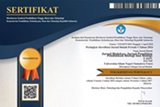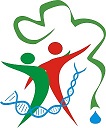The effect of genitri (Elaeocarpus ganitrus) in leukocytes profile of wistar rats as a prospective immunomodulatory agent
Abstract
Immunomodulator is an agent to activate and modulate the immune response. It is one of the approaches to prevent chronic disease and maintain homeostasis. Recently, plant phytochemicals have been developed as prospective immunomodulatory agents. Genitri (Elaeocarpus ganitrus), a local plant cultivated in Indonesia, exhibited various biological properties and potential as an immunomodulatory agent. This study aims to identify the potency of genitri as immunomodulatory agent through leukocyte profiling. Genitri leaf (P1), seed (P2), and fruit (P3) were prepared as powder and administered to male wistar rats weighted 250-300 g twith six replications for 28 days. The total leukocytes were counted and leukocytes were being profiled following the treatment with genitri powder then compared with control treatment (P0). The immunomodulatory activity of genitri was shown by the increased leukocytes count following treatment. Based on data from the treatment group (P2), genitri seeds were able to increase leukocytes by 10595.83 cells/µl. The highest total leukocytes were found in treatment P2 with total leukocytes 10595.83 cells/µl. Based on the leukocyte profile, lymphocytes and monocytes were found to be the highest in all treatments. Treatment with genitri was able to stimulate an increase in lymphocytes and monocytes. An increase in total leukocytes given genitri is an indication of an increased immune response.
Keywords
Full Text:
PDFReferences
Afrianti, R., Ramadheni, P., & Irsanti, P N. (2017). Uji aktivitas estrogenik ekstrak etanol jintan hitam (Nigella sativa L.) terhadap perkembangan uterus tikus putih betina. Scientia, 7(1), 49–55.
Agidew, M. G. (2022). Phytochemical analysis of some selected traditional medicinal plants in Ethiopia. Bulletin of the National Research Centre, 46(87), 1-22. https://doi.org/10.1186/s42269-022-00770-8
Ali, S. A., Singh, G., & Datusalia, A. K. (2021). Potential therapeutic applications of phytoconstituents as immunomodulators: Pre-clinical and clinical evidences. Phytotherapy Research: PTR, 35(7), 3702–3731. https://doi.org/10.1002/ptr.7068
Alturkistani, H. A., Tashkandi, F. M., & Mohammedsaleh, Z. M. (2015). Histological stains: A literature review and case study. Global Journal of Health Science, 8(3), 72-9. https://doi.org/10.5539/gjhs.v8n3p72
Arscott, W. T., Soltys, J., Knight, J., & Mao-Draayer, Y. (2011). Interferon β-1b directly modulates human neural stem/progenitor cell fate. Brain Research, 1413, 1–8. https://doi.org/10.1016/j.brainres.2011.07.037
Bhatti, M. Z., Ismail, H., & Khan Kayani, W. (2022). Plant Secondary Metabolites: Therapeutic Potential and Pharmacological Properties. IntechOpen. https://doi.org/10.5772/intechopen.103698
Bindu, S., Mazumder, S., & Bandyopadhyay, U. (2020). Non-steroidal anti-inflammatory drugs (NSAIDs) and organ damage: A current perspective. Biochemical Pharmacology, 180(1), 114147. https://doi.org/10.1016/j.bcp.2020.114147
Bonilla, F. A., & Oettgen, H. C. (2010). Adaptive immunity. Journal of Allergy and Clinical Immunology, 125(2), S33-S40.
Borriello, F., Iannone, R., & Marone, G. (2017). Histamine Release from Mast Cells and Basophils. Handbook of Experimental Pharmacology, 241, 121–139. https://doi.org/10.1007/164_2017_18
Brindha, P. (2016). Role of phytochemicals as immunomodulatory agents: A review. International Journal of Green Pharmacy (IJGP), 10(1), 1-18. https://doi.org/10.22377/ijgp.v10i1.600
Cahyaningsih, R., Magos Brehm, J., & Maxted, N. (2021). Gap analysis of Indonesian priority medicinal plant species as part of their conservation planning. Global Ecology and Conservation, 26, e01459. https://doi.org/10.1016/j.gecco.2021.e01459
Hooda, P., Malik, R., Bhatia, S., Al-Harrasi, A., Najmi, A., Zoghebi, K., Halawi, M. A., Makeen, H. A., & Mohan, S. (2024). Phytoimmunomodulators: A review of natural modulators for complex immune system. Heliyon, 10(1), e23790. https://doi.org/10.1016/j.heliyon.2023.e23790
Hohakay, J. J., Pontoh, J., & Yudistira, A. (2019). Pengaruh metode pengeringan terhadap kadar flavonoid daun sesewanua (clerodendron squamatum vahl.). Pharmacon, 8(3), 748-757.
https://doi.org/10.35799/pha.8.2019.29401
Hultquist, Judd F., Schumann, K., Woo, Jonathan M., Manganaro, L., McGregor, Michael J., Doudna, J., Simon, V., Krogan, Nevan J., & Marson, A. (2016). A Cas9 Ribonucleoprotein Platform for Functional Genetic Studies of HIV-Host Interactions in Primary Human T Cells. Cell Reports, 17(5), 1438–1452. https://doi.org/10.1016/j.celrep.2016.09.080
Karasuyama, H., Obata, K., Wada, T., Tsujimura, Y., & Mukai, K. (2011). Newly appreciated roles for basophils in allergy and protective immunity. Allergy, 66(9), 1133–1141. https://doi.org/10.1111/j.1398-9995.2011.02613.x
Kelly, M., Hwang, J.M., Kubes, P. (2007). Modulating leukocyte recruitment in inflammation. Journal of Allergy and Clinical Immunology, 120(1), 3–10. https://doi.org/10.1016/j.jaci.2007.05.017
Kim, M.-J., Kim, Y.-Y., Choi, Y.-A., Baek, M.-C., Lee, B., Park, P.-H., Shin, T.-Y., Kwon, T. K., Khang, D., & Kim, S.-H. (2018). Elaeocarpusin Inhibits Mast Cell-Mediated Allergic Inflammation. Frontiers in Pharmacology, 9(591), 1-9. https://doi.org/10.3389/fphar.2018.00591
Lee, Z.-Y., Tam, J. K. C., & Tran, T. (2021). Corticosteroid use in respiratory viral infections — friend or foe?. Current Opinion in Physiology, 22, 100450. https://doi.org/10.1016/j.cophys.2021.06.004
Liu, J.-K. (2022). Natural products in cosmetics. Natural Products and Bioprospecting, 12(40), 1-43. https://doi.org/10.1007/s13659-022-00363-y
Luster, A. D., Alon, R., & von Andrian, U. H. (2005). Immune cell migration in inflammation: present and future therapeutic targets. Nature Immunology, 6(12), 1182–1190. https://doi.org/10.1038/ni1275
Mahmoudi, F., Hadi, M., Azadeh Montaseri, Mohamed Khosroshahi, L., & Behzad Baradaran. (2024). Microbial natural compounds and secondary metabolites as Immunomodulators: A review. International Journal of Biological Macromolecules, 278(3), 134778–134778. https://doi.org/10.1016/j.ijbiomac.2024.134778
Majka, M., Sułkowski, M., Badyra, B., & Musiałek, P. (2017). Concise Review: Mesenchymal Stem Cells in Cardiovascular Regeneration: Emerging Research Directions and Clinical Applications. STEM CELLS Translational Medicine, 6(10), 1859–1867. https://doi.org/10.1002/sctm.16-0484
Manoharan, K., & Chitra, P. C. (2022). Hypoglycemic and Hypolipidemic Activities of Ethanolic Extract of Elaeocarpus Tectorius (Lour.) Poir. Leaves in Streptozotocin- Nicotinamide Induced Diabetic Rats. Biomedical and Pharmacology Journal, 15(2), 1167–1178. https://doi.org/10.13005/bpj/2453
Marshall, J.S., Warrington, R., Watson, W., & Kim, H.L. (2018). An introduction to immunology and immunopathology. Allergy Asthma Clin Immunol, 14(49), 5-14. https://doi.org/10.1186/s13223-018-0278-1
Mešťanová, V., & Varga, I. (2016). Morphological view on the evolution of the immunity and lymphoid organs of vertebrates, focused on thymus. Biologia, 71(10). https://doi.org/10.1515/biolog-2016-0137
Ministry of Agriculture. (2014). Renstra Kementrian Pertanian Pertanian Tahun 2015 - 2019 (Strategic Plan of Ministry of Agriculture 2015-2019). Ministry of Agriculture of Republic of Indonesia
Ministry of Agriculture. (2015). Agricultural Statistics. Ministry of Agriculture Republic of Indonesia
Ministry of National Development Planning. (2016). Indonesian Biodiversity Strategy and Action Plan 2015-2020. Indonesian Government
Mukherjee, P., Nema, N., Bhadra, S., Mukherjee, D., Braga, F., & Matsabisa, M. (2014). Immunomodulatory leads from medicinal plants. Indian Journal of Traditional Knowledge, 13(2), 235–256.
Myers, N., Mittermeier, R. A., Mittermeier, C. G., da Fonseca, G. A. B., & Kent, J. (2000). Biodiversity hotspots for conservation priorities. Nature, 403(6772), 853–858.
Navegantes, K. C., de Souza Gomes, R., Pereira, P. A. T., Czaikoski, P. G., Azevedo, C. H. M., & Monteiro, M. C. (2017). Immune modulation of some autoimmune diseases: the critical role of macrophages and neutrophils in the innate and adaptive immunity. Journal of Translational Medicine, 15(1), 36. https://doi.org/10.1186/s12967-017-1141-8
Orakpoghenor, O., Avazi, D. O., Markus, T. P., & Olaolu, O. S. (2019). Lymphocytes: a brief review. SCIRES Lit, 3(1), 005-8.
Peluso, I., Miglio, C., Morabito, G., Ioannone, F., & Serafini, M. (2014). Flavonoids and Immune Function in Human: A Systematic Review. Critical Reviews in Food Science and Nutrition, 55(3), 383–395. https://doi.org/10.1080/10408398.2012.656770
Prabowo, N. A., Nurudhin, A., & Buanantri, A. C. (2021, January). The Effect of Moringa Oleifera Leaf Extract on Mean Platelet Volume and Neutrophil-to-Lymphocyte Ratio in Autoimmune Patients. 4th International Conference on Sustainable Innovation 2020–Health Science and Nursing (ICoSIHSN 2020) (625-629). Atlantis Press.
Primiani, C. N., Pujiati, P., & Setiawan, M. A. (2021). Phytochemical constituents and antimicrobial activity of Elaeocarpus sphaericus Schum seed extract. Tropical Journal of Natural Product Research, 5(10), 1775-1781.
Primiani, C. N., Sari, D. R., Krisnamurti, G. C., Pujiati, P., & Setiawan, M. A. (2022). Anti-Inflammatory Potentials of Elaeocarpus sphaericus Schum Fruit Compounds by Molecular Docking Approach. Tropical Journal of Natural Product Research, 6(10), 1663-1669.
Primiani, C. N., Bhagawan, W. S., Pujiati, P., & Sari, D. R. T. (2024). Phytochemical screening, in vitro and in silico antibacterial investigation of Elaeocarpus ganitrus extract. Jurnal Biota, 10(1), 1–14. https://doi.org/10.19109/biota.v10i1.20038
Prinyakupt, J., & Pluempitiwiriyawej, C. (2015). Segmentation of white blood cells and comparison of cell morphology by linear and naïve Bayes classifiers. BioMedical Engineering OnLine, 14(63), 1-19. https://doi.org/10.1186/s12938-015-0037-1
Qu, T., Gao, Y., Li, A., Li, Z., & Qin, X. (2021). Systems biology analysis of the effect and mechanism of total flavonoids of Astragali Radix against cyclophosphamide-induced leucopenia in mice. Journal of Pharmaceutical and Biomedical Analysis, 205, 114357–114357. https://doi.org/10.1016/j.jpba.2021.114357
Rahman, H., Aldi, Y., & Mayanti, E. (2017). Aktifitas Imunomodulator Dan Jumlah Sel Leukosit Dari Ekstrak Kulit Buah Naga Merah (Hylocereus lemairei (Hook.) Britton & Rose) Pada Mencit Putih Jantan. Jurnal Farmasi Higea, 8(1), 44–58. https://doi.org/10.52689/higea.v8i1.137
Ribeiro, D., Freitas, M., Tomé, S. M., Silva, A. M., Laufer, S., Lima, J. L., & Fernandes, E. (2015a). Flavonoids inhibit COX-1 and COX-2 enzymes and cytokine/chemokine production in human whole blood. Inflammation, 38, 858-870.
Ribeiro, D., Freitas, M., Lima, J. L., & Fernandes, E. (2015b). Proinflammatory pathways: the modulation by flavonoids. Medicinal research reviews, 35(5), 877-936.
Salim, A. N., Sumardianto, S., & Amalia, U. (2018). Efektivitas serbuk simplisia biji pepaya sebagai antibakteri pada udang putih (Penaeus merguensis) selama penyimpanan dingin. Jurnal Pengolahan Hasil Perikanan Indonesia, 21(2), 188-198.
https://doi.org/10.17844/jphpi.v21i2.22836
Saranraj, P., Sivasakthi, S., & Deepa, M. S. (2016). Phytochemistry of pharmacologically important medicinal plants – A Review. International Journal of Current Research in Chemistry and Pharmaceutical Sciences, 3(11), 56–66. https://doi.org/10.22192/ijcrcps.2016.03.11.009
Sarkar, A., & Bhattacharjee, S. (2019). Terpenoids in Treatment of Immunological Disease. CRC Press Ebooks. https://doi.org/10.1201/9781351026703-6
Selvakumar, P. M., Rajkumar S, R. J., & MSA, M. N. (2018). Phytochemicals as a potential source for anti-microbial, anti-oxidant and wound healing - a review. MOJ Bioorganic & Organic Chemistry, 2(2), 61-70. https://doi.org/10.15406/mojboc.2018.02.0058
Shi, F., Xue, R., Zhou, X., Shen, P., Wang, S., & Yang, Y. (2021). Telitacicept as a BLyS/APRIL dual inhibitor for autoimmune disease. Immunopharmacology and Immunotoxicology, 43(6), 666–673. https://doi.org/10.1080/08923973.2021.1973493
Shukla, S., Bajpai, V. K., & Kim, M. (2014). Plants as potential sources of natural immunomodulators. Reviews in Environmental Science and Bio/Technology, 13(1), 17–33. https://doi.org/10.1007/s11157-012-9303-x.
Shukla, M. K., Singh, S. K., Pandey, S., Gupta, P. K., Choudhary, A., Jindal, D. K., Dua, K., & Kumar, D. (2022). Potential Immunomodulatory Activities of Plant Products. South African Journal of Botany, 149, 937-943 https://doi.org/10.1016/j.sajb.2022.04.055
Sriwanthana, B., Treesangsri, W., Boriboontrakul, B., Niumsakul, S., & Chavalittumrong, P. (2007). In vitro effects of Thai medicinal plants on human lymphocyte activity. Songklanakarin Journal of Science and Technology, 29 (Suppl. 1), 17-28.
Strzelec, M., Detka, J., Patrycja Mieszczak, Małgorzata Katarzyna Sobocińska, & Majka, M. (2023). Immunomodulation—a general review of the current state-of-the-art and new therapeutic strategies for targeting the immune system. Frontiers in Immunology, 14, 1127704. https://doi.org/10.3389/fimmu.2023.1127704
Sultana, S., & Biswadev Bishayi. (2019). Potential anti-arthritic and anti-inflammatory effects of TNF-α processing inhibitor-1 (TAPI-1): A new approach to the treatment of S. aureus arthritis. Immunobiology, 225(2), 151887–151887. https://doi.org/10.1016/j.imbio.2019.11.022
Sun, H., Huo, Y., & Fan, Z. (2021). Editorial: Imaging and Mechanism of Leukocyte Recruitment and Function in Inflammation and Infections. Frontiers in Cell and Developmental Biology, 9(690003), 1-5. https://doi.org/10.3389/fcell.2021.690003
Tripathi, Y. C., Shukla, P., & Tewari, D. (2014). Phytochemical Evaluation and Antihyperglycemic Effects Of Elaeocarpus Ganitrus Roxb (Rudraksha) In Streptozotocin Induced Diabetes. International Journal of Pharmacy and Pharmaceutical Sciences, 7(1), 280–283.
Turvey, S. E., & Broide, D. H. (2010). Innate immunity. Journal of Allergy and Clinical Immunology, 125(2), S24-S32.
Vinay, S. P., Udayabhanu, Sumedha, H. N., Shashank, M., Nagaraju, G., & Chandrasekhar, N. (2021). In-vitro antibacterial, antioxidant and cytotoxic potential of gold nanoparticles synthesized using novel Elaeocarpus ganitrus seeds extract. Journal of Science: Advanced Materials and Devices, 6(1), 127–133. https://doi.org/10.1016/j.jsamd.2020.09.008
Zaragozá, C., Villaescusa, L., Monserrat, J., Zaragozá, F., & Álvarez-Mon, M. (2020). Potential Therapeutic Anti-Inflammatory and Immunomodulatory Effects of Dihydroflavones, Flavones, and Flavonols. Molecules, 25(4), 1017. https://doi.org/10.3390/molecules25041017
Zhang, X.-H., Tee, L. Y., Wang, X.-G., Huang, Q.-S., & Yang, S.-H. (2015). Off-target Effects in CRISPR/Cas9-mediated Genome Engineering. Molecular Therapy - Nucleic Acids, 4(1), e264. https://doi.org/10.1038/mtna.2015.37
DOI: http://dx.doi.org/10.30821/biolokus.v8i1.3987
Refbacks
- There are currently no refbacks.
Copyright (c) 2025 Jurnal Biolokus: Jurnal Penelitian Pendidikan Biologi dan Biologi
indexed by :












